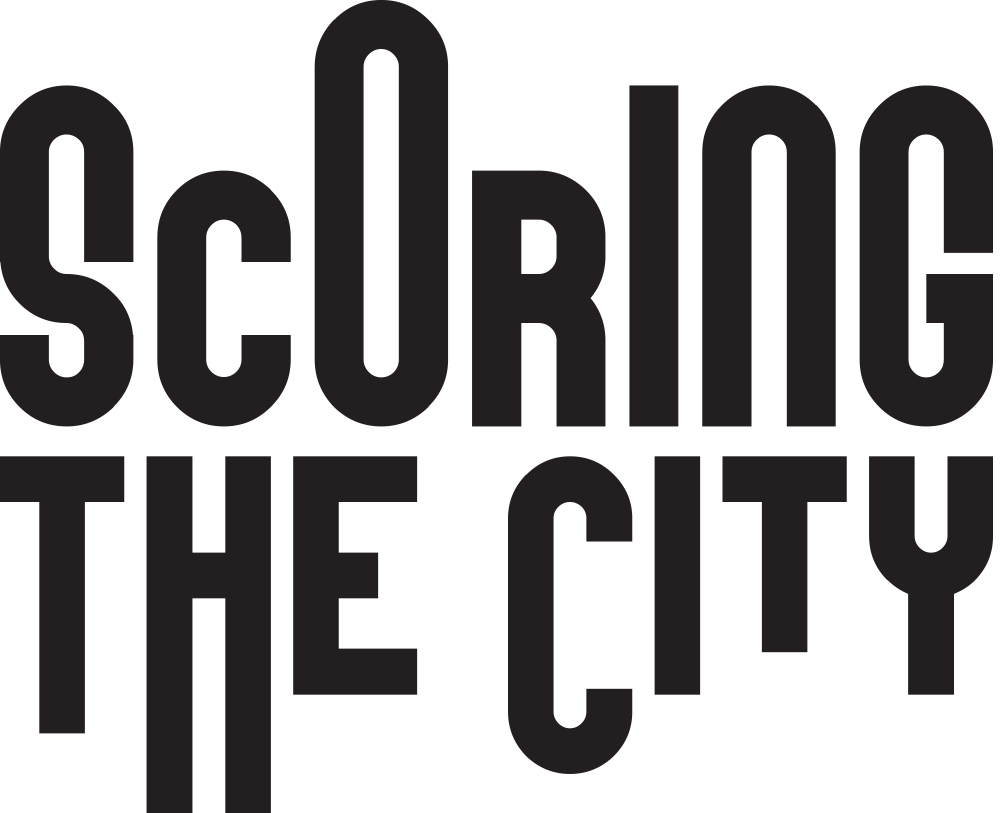Scoring the City: Musical, Architectural and Urban Notations
by Gascia Ouzounian
Can a score be a blueprint for social change? For revolution? Certainly those questions motivated composers like Cornelius Cardew, whose graphic scores and text scores upended performance conventions in 1960s England, enabling trained and ‘untrained’ musicians to collaborate in bringing to life music that was centrally concerned with ideas of community, collectivity, interdependence, and revolution; or Anthony Braxton, whose graphic notation systems, rooted equally in musical and spiritual philosophies, provide a route toward deeply creative collective improvisation, what Braxton calls ‘interactive strategies’—and whose scores, if played ‘too correctly,’ are probably ‘played wrong’ (Braxton 2004, 204); or Yoko Ono, whose Haiku-esque verbal scores invite acts of social transgression, with one instructing a soprano to ‘Scream / against the wind / against the wall / against the sky’ (Ono 1961).
Such scores and notational systems do much more than extend musical languages or suggest new musical forms. They are fundamentally concerned with social and political questions; and they encode modes of collectivity, sociality, and democratic decision-making.
When we came together for the Scoring the City project, we sought to transpose such ideas, emerging from musical cultures, onto the domain of architecture and urban design. The project was an experiment: what might architecture and urban design look like if its notations—for example, blueprints and plans—were not fixed forms, but rather open, unstable, and dynamic? What would it mean for architectural drawings and urban plans to encode the same kinds of approaches to improvisation, collective decision-making, and social action embedded in such musical scores? How might such approaches to urban design enable a different kind of public life to emerge? Can a city be democratically scored? Can it be scored for improvisation, play, interaction?
For the first phase of this project we hosted workshops for groups of 15 architects, urban designers, composers and artists, in each of four cities: London, Beirut, Belfast, and Paris. Each workshop began with a different series of prompts—brief presentations, musical performances, visual essays, discussions of readings, collective improvisations—that, we hoped, would centre these questions and invite critical discussion among the group.
One prompt, by the Belfast-based drummer and improviser Steve Davis, entailed his interpretations of graphic scores by Earl Brown (December 1952) and Wadada Leo Smith (Compositions No. 110C, 115, and 336C). Following his performance, the group asked Steve questions about his interpretative approach. Why did he make the choices he made, for example in navigating a score in a particular direction? What ideas did he seek to transmit through those choices, if any, and how did those ideas connect to particular notations? Did his performances represent ‘faithful’ readings of scores, or did he use scores as a more of a general prompt—an inspiration? What, for him, made a successful interpretation of an open score versus a failed one, and why?
For his prompt at the London workshop, the urban sociologist Richard Sennett traced a history of architectural notations, from the rudimentary drawings that gave rise to complex medieval European architectures—drawings that depended on rich craft traditions and the embodied knowledge of local craftspeople to enact—to the much more specified architectural blueprints that emerged in connection steel-skeleton buildings in the late nineteenth century, which required industrial fabrication to build. Most provocatively, he drew attention to a new kind of architectural notation currently circulating in global markets: not an architectural blueprint per se but a generic set of specifications: a ‘spec list’ that can be marketed to global investors who might not have any interest in the local context of a development but who can afford to purchase a stake in it. Sennett’s prompt invited us to consider how such notations, based on the flows of global capital instead of any concern for local conditions, resulted in rigid, generic, impersonal spaces—what we might think of as ‘ultra-planned’ sites.
The idea of a more open and unplanned urban score that we sought to explore through Scoring the City resonated with Sennett’s work on open cities more broadly (see Sennett 2018; see also Kostourou’s essay in this collection). More recently, in Sennett’s project Designing Disorder with architect Pablo Sendra, the authors write, ‘A vital and open city does not occur naturally. There are places where improvised activities and social interaction do not happen because the rigidity of the urban environment does not allow this improvisation to take place, and planning for disorder is necessary’ (Sendra and Sennett 2019, 3). Sennett and Sendra ask, how can designers plan for disorder? The Scoring the City experiment posed a similar question in connection to graphic notation and the visual representation of city spaces.
In our Beirut workshop, the singer-songwriter, sound artist, and musicologist Youmna Saba introduced musical notation systems that had developed in the Middle East from antiquity to the present day. She drew attention to such notations as the cuneiform inscriptions of the Hurrian Hymn to Nikkal, etched on clay tablets (Ugarit, Northern Syria, 1400-1200 BC); as well as the complex drawings and graphic notations developed by musician-theorists including Safi al-Din al-Urmawi (Baghdad, 13th century), Qutb al-Din al-Shirazi (Shiraz, 13th century), Shamseddine Al Sidwai (Damascus, 16th century), and Mikhail Mashaqa (Syria, 19th century). Their notations, Saba told us, were not typically intended as tools for performance or composition but were rather used to develop and visually represent theories of rhythm, pitch, interval, modulation, and mode.
Saba also reflected on her own compositional practice, in which she sometimes uses graphic notations, notably her project 1.2 seconds ago – travelling notes (2016), which she describes as ‘a tune in motion: a “ritournelle” composed in the city of origin (Beirut) that undergoes changes as it travels along an expedition path. Scales, rhythms, patterns and textures are extracted from each stop, altering the songwriter and her songwriting process’ (Saba 2016). Saba’s graphic notations for 1.2 seconds ago depicted, in one case, a mapping of her walking trip in one part of Madrid, one of the cities in which the project took place. She writes, ‘This map was translated into a score for a music box which served as a reinterpretation of the initial tune’ (Saba 2020). In another case, a graphic score was generated from the movement of passers-by in Plaza de Chueca, Madrid; Saba used this score to generate another version of the initial tune.
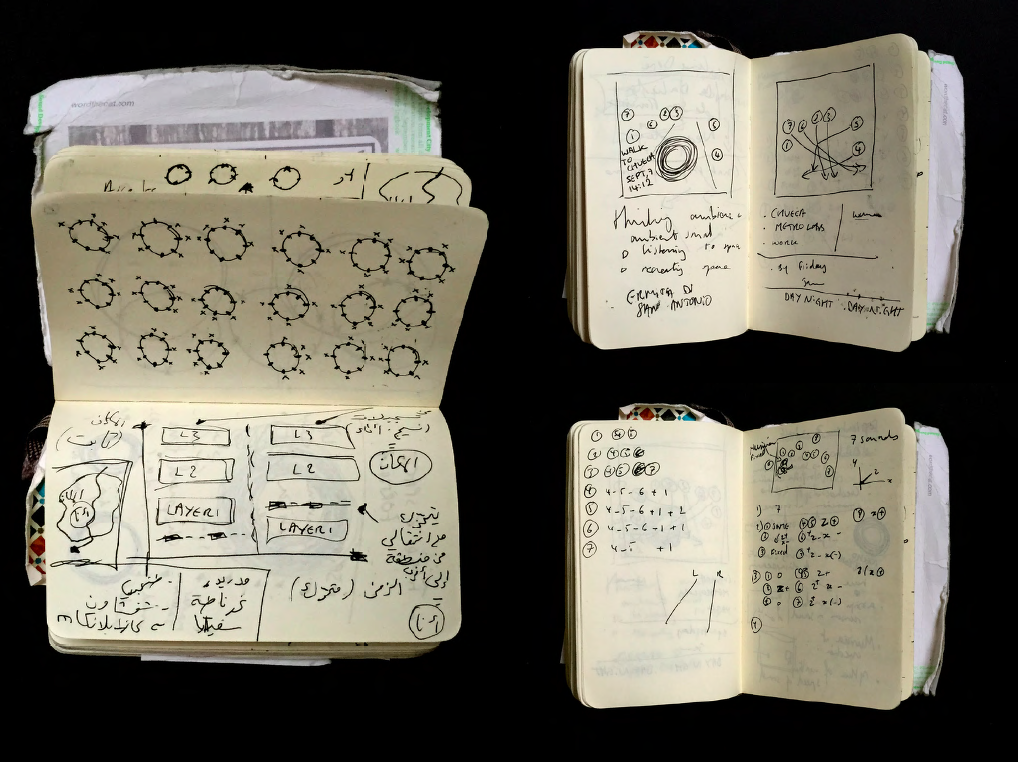
Youmna Saba, notes on 1.2 seconds ago – travelling notes (2016) (project developed during Sound Development City artist expedition). © Youmna Saba 2016. Used with permission.
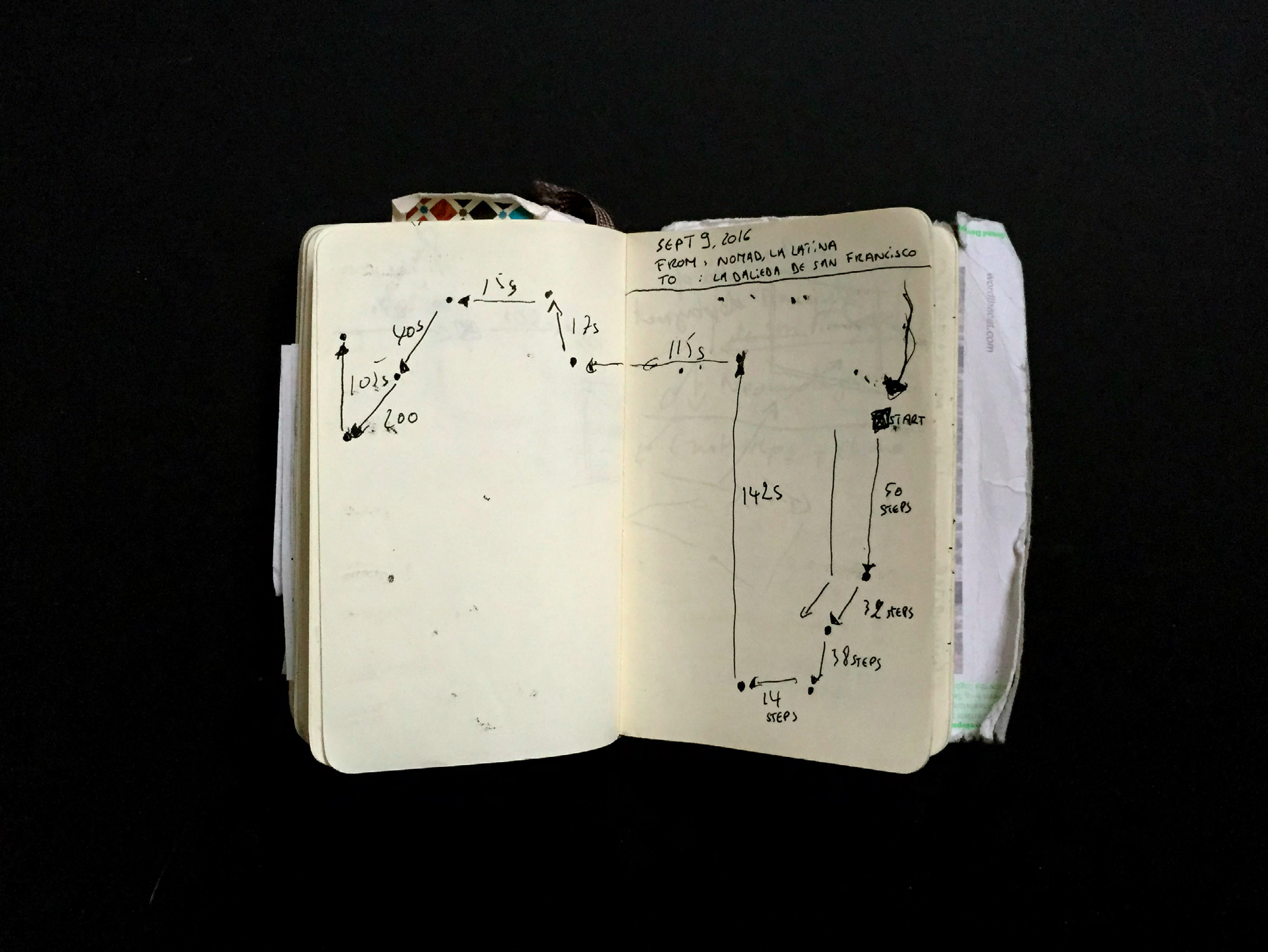
Youmna Saba, notations for 1.2 seconds ago – traveling notes (2016) (project developed during Sound Development City artist expedition). © Youmna Saba 2016. Used with permission.
My own prompt at various Scoring the City workshops invited participants to simply observe a series of 27 scores and drawings, both musical and architectural in nature. I chose musical scores whose notations evoked architectural and urban forms—and, conversely, architectural and urban drawings that evoked music. Morton Feldman’s composition Intersection #1 For Orchestra (1951), for example, resembled the traffic charts found in many urban plans. Conversely, Louis Khan’s Traffic Study Project, Philadelphia, PA (1952), an actual traffic chart, had markings that depicted a musical kind of flow, and even had symbols that resembled musical dynamic markings. On a strictly visual level these notations were not so different.
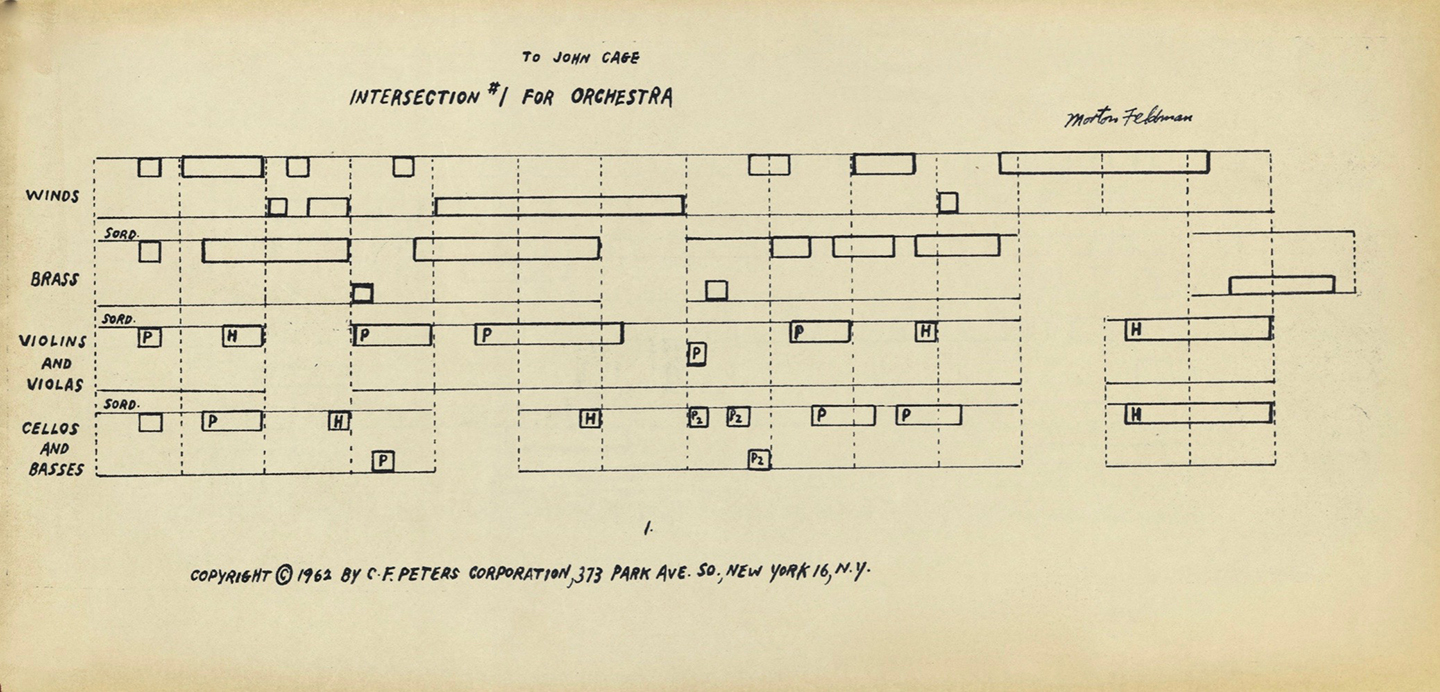
Morton Feldman, Intersection #1 for Orchestra (1951). © 1962, C.F. Peters Corp.
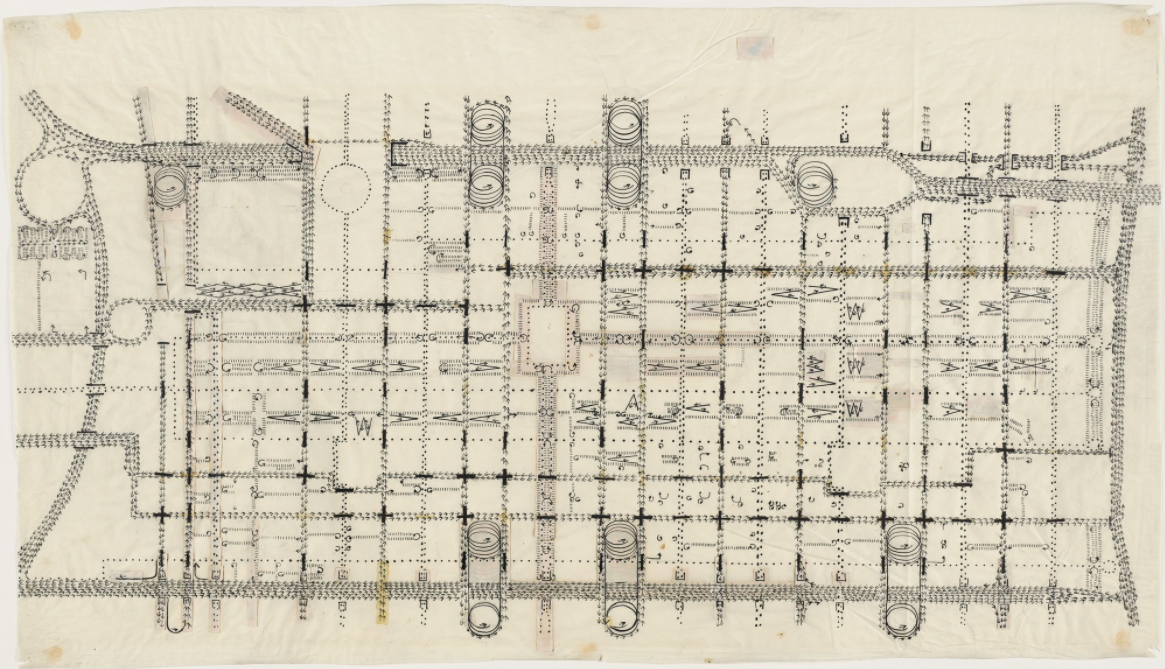
Louis I. Kahn, ‘Traffic Study project, Philadelphia, PA (Plan of proposed traffic-movement pattern)’ (1952). © Estate of Louis I. Kahn.
Some scores and drawings were more explicit in their musical-architectural allusions. Bernard Tschumi’s Notation for the Tokyo Opera (1986), for example, was an architectural plan in which musical symbols doubled as structural forms. Coming from the other direction, so to speak, were works like Luciano Ori’s La Città sconvolta (The Shocked City) (1980), a symphonic poem in which an urban plan is reconstituted as a musical score, complete with performance instructions. The Shocked City must be played ‘with great abandon’ (‘Con grande abbandono’); ‘with deep expression’ (‘Con profonda espressione’); and, at a certain point, ‘with a sharp contrast of extreme violence and passionate tenderness’ (‘Con un brusco contrasto di estrema violenza e di appassionata tenerezza’). The performer of this city-score is even given a tempo marking. Perhaps to enable such expressive qualities to emerge, The Shocked City should be played adagio.
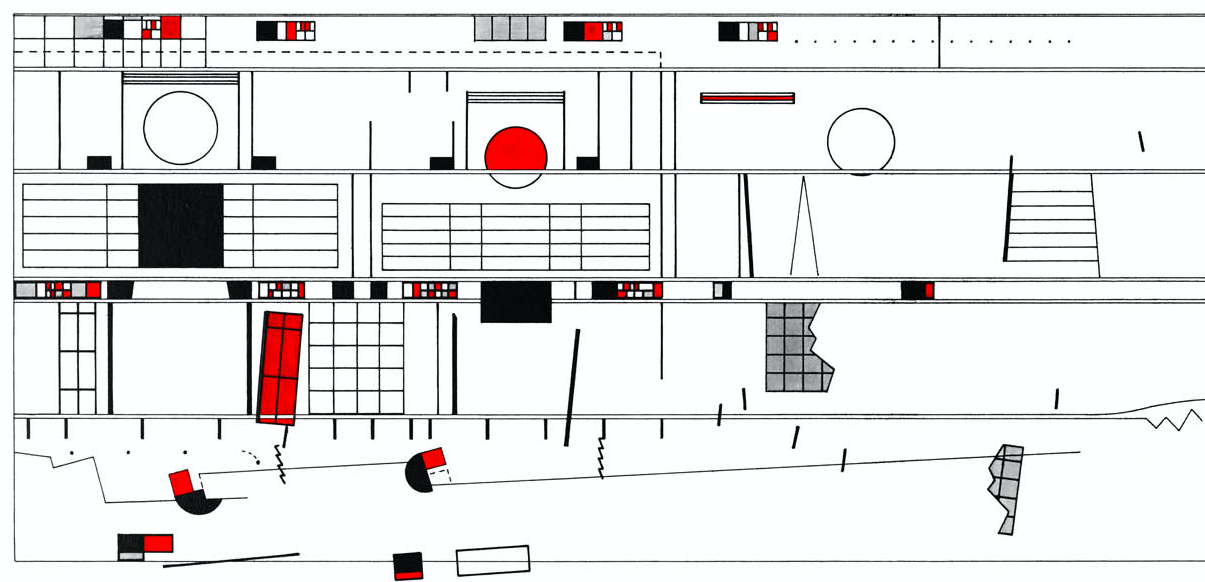
Bernhard Tschumi, New National Theatre, Tokyo (1986). © BTA 1986.
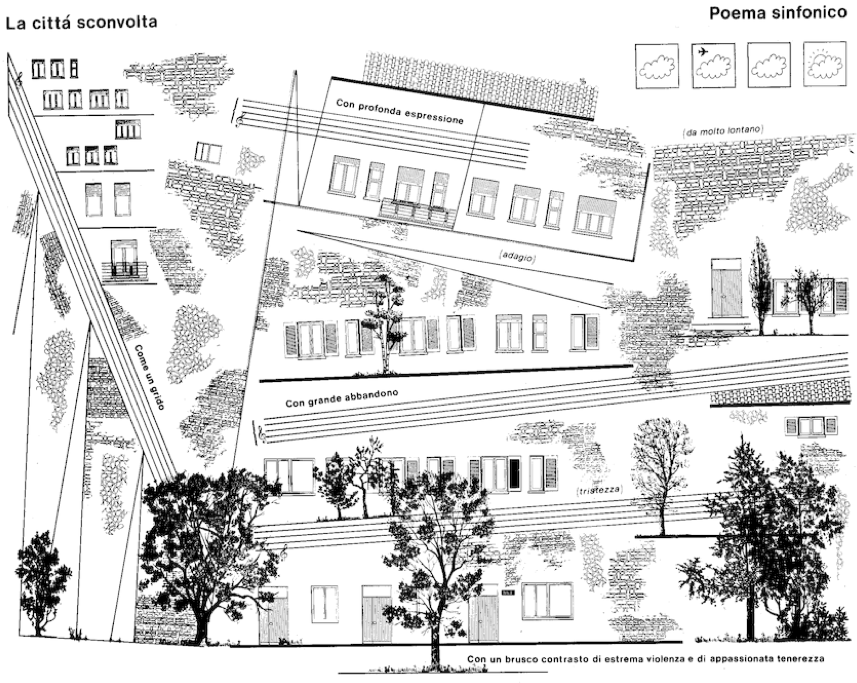
Luciano Ori, La Città Sconvolta [The Shocked City: Symphonic Poem] (1980). © Luciano Ori 1980.
For this prompt it was not necessary to know the full background to each score or to map out its myriad potential realisations. Rather, the idea was to observe the visual languages and notational strategies that various artists, architects, and planners had used. In what ways could a score encode expressive possibilities, and how might those possibilities map out onto musical, architectural, and urban domains—but equally, onto social, cultural, and political ones?
Following the prompts, we visited a local site in each city—a building, a street, a neighbourhood—and considered its social and spatial conditions. In Belfast, Terri McKeown, a community organiser and activist, guided participants through Sailortown, a vibrant working-class urban village that was razed in the 1960s to make room for a motorway. Today the Sailortown site is an emblem of both urban renewal and decay. On the one hand, new high-rise condominiums, office blocks, hotels, and tourist attractions represent economic growth and opportunity. On the other hand, the area has been stripped of much of its local character, with once legendary pubs like Pat’s Bar and the Rotterdam reduced to mere façades. St Joseph’s Chapel, a community landmark, exists in a state of perpetual disrepair, unable to reopen because the financing for repairs drips in too slowly. Adding insult to injury, the Sailortown site has itself become a kind of tourist attraction for a forgotten industrial past. Plaques announcing that this was Sailortown dot the area, as do images of former Sailortown residents, bringing markers of place to what is becoming a generic ‘non-place’. In other words, the city trades on this rich cultural heritage even as it diminishes it and drives it out.
Following the site visits, we invited workshop participants to create a score that responded to that site and connected to the themes of the day: memory, forgetting, displacement, gentrification, ineffectual government, and more. If they were going to create an architectural score that reimagined that site and its future, what would they draw?
Many of the scores featured on the Scoring the City website today are derived from these initial sketches. The architect Jake Johnson’s score for Sailortown, for example, recovers markers of place in an area where place is under threat. Taking inspiration from Luciano Ori’s The Shocked City and Richard Sennett’s essay ‘Five Open Forms’, the architect Fani Kostourou’s score for the fenced-off Chapelle Charbon site in Paris reimagines a dead terrain vague as a place full of life. Kostourou’s Chapelle Charbon emerges not as a closed, non-descript, inactive, urban black hole. Rather, it reveals points of dynamism that might otherwise be lost, particularly those that are revealed through the site’s soundscape. The architect and artist Mhamad Safa’s Variations for Winds and Drones uses ray-tracing of acoustic reflections to explore the connections between acoustic vibrations, social inequality, and urban architecture in the Ouazi district of Beirut, whose infrastructural failings Safa connects to years of ‘planned exclusion’.
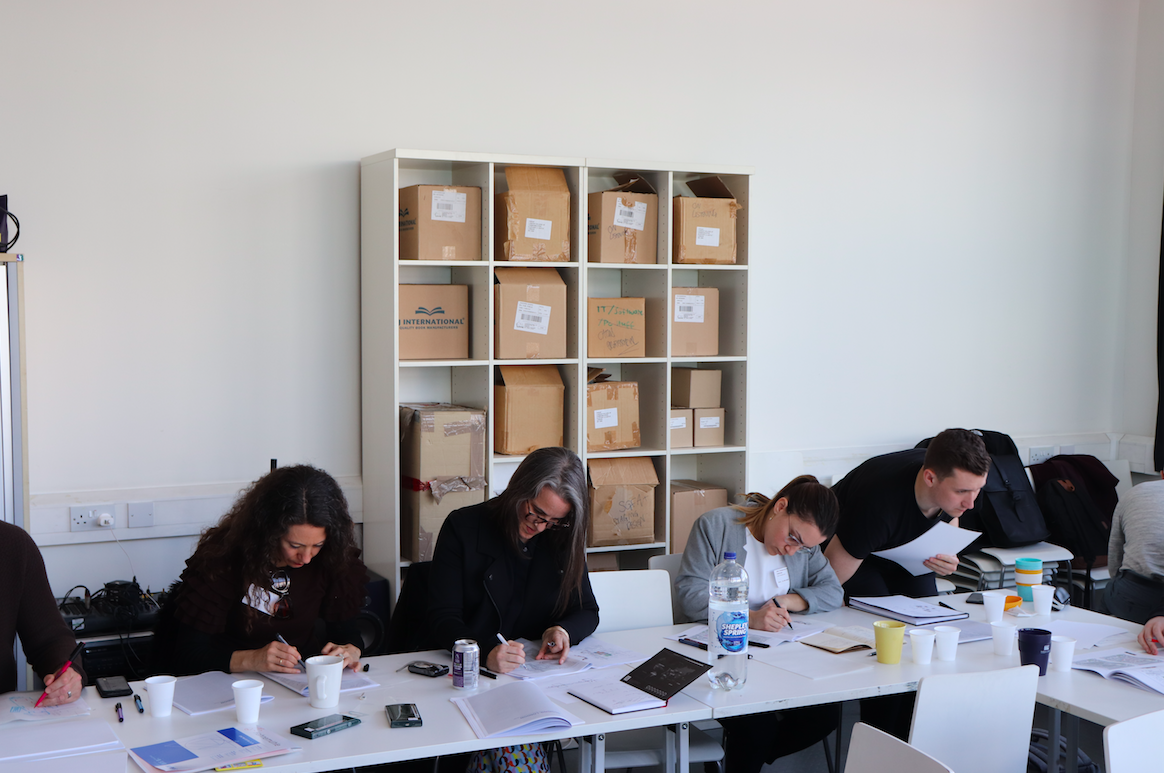

These and other propositional scores that emerged from the Scoring the City workshops use a variety of strategies to reimagine, revifify, and reopen closed, bounded, and unused or inactive spaces. Responding to the Chapelle Charbon site, the urban designer Rennie Tang and movement analyst/dance educator Lisa Sandlos seek to ‘unwall the city’ by creating a ‘moving score’ that reinserts playful bodily movement into a fenced-off, seemingly immobile and immobilising site. The composer Jonathan Packham’s score for the same site challenges the outwardly ‘resistant physical boundary’ of the Chapelle Charbon fence by highlighting noises that might make ‘previously rigid physical boundaries seem—at least momentarily—less resistant’. Diogo Alvim’s composition for Chapelle Charbon, scored for 8 brass players who occupy strategic points around the site (‘viewpoints, borders, old barriers, dead-ends or future entrances’) is rooted in call-and-response, improvisation, and harmonization. The sound artist Eleni-Ira Panourgia and landscape architect David Buck create what they call ‘sonic passages’ that disrupt the site’s physical boundaries ‘by allowing an exchange of activity inside, outside and around sites;’ while the designer Carla Moujan’s score for Chapelle Charbon activates the site’s edges, seeking to ‘counteract opacity, hostility and dullness’ by composing ‘a choreography of sensations, actions, and paths.’
These open scores-for-cities are rooted in sensorial experience, in the body’s coming-into-being with place and with other bodies and with non-human actors through listening, sound-making, dialoguing, moving, singing, observing, activating. Many imagine sound and vibration as a connective tissue that creates leaks and openings in what are otherwise hard boundaries, membranes, borders, and edges. Many also embrace the unknown, the incidental, the indeterminate, and the ‘unscorable’. The sound artist Una Lee’s composition for Sailortown, for example, scored for a vocal ensemble, highlights the indeterminate boundaries between voice and wind: ‘Translated as a human breath in this piece, blending with and crossing over to voice and back, the wind exists over the borders between sea and almost-sea, past and barely-present, Sailortown and the rest of the world.’ The artist and musician Sharon Phelan’s composition for Chapelle Charbon emerges as an implied or perhaps immanent score. She writes, ‘How do you score liminality? “A map is a matter of performance” wrote Deleuze & Guattari in On the Line. I decide to make a concrete survey. Perhaps then, between the lines, a score will emerge’.
These propositional scores invite us to reconsider potentials, thresholds, and in-between states in urban spaces. Notably, none are prescriptive. Even those with more concrete instructions are rooted in spontaneity, chance, openness, improvisation, and play. Taken together, they ask how the urban plan might be reimagined as a site of possibility, disruption, and connection: a living city scored as such.
Works Cited
Braxton, Anthony. 2006. ‘Introduction to Catalog of Works.’ In Christoph Cox and Daniel Warner, eds. Audio Culture: Readings in Modern Music, pp. 201-206. New York and London: Continuum.
Kostourou, Fani. 2020. ‘From open forms to open scores’. Scoring the City. http://scoring.city/library/essays/from-open-forms-to-open-scores/
Saba, Youmna. 2016. ‘1.2 seconds ago – traveling notes.’ Soundcloud. https://soundcloud.com/youmna-saba/12-seconds-ago-travelling-notes
Saba, Youmna. 2020. Correspondence with the author. Unpublished.
Sennett, Richard. 2018. Building and Dwelling: Ethics for the City. UK: Allen.
Sennett, Richard, and Pablo Sendra. 2020. Designing Disorder: Experiments and Disruptions in the City. London: Verso.
Ono, Yoko. 1961. Voice Piece for Soprano. [Score].
